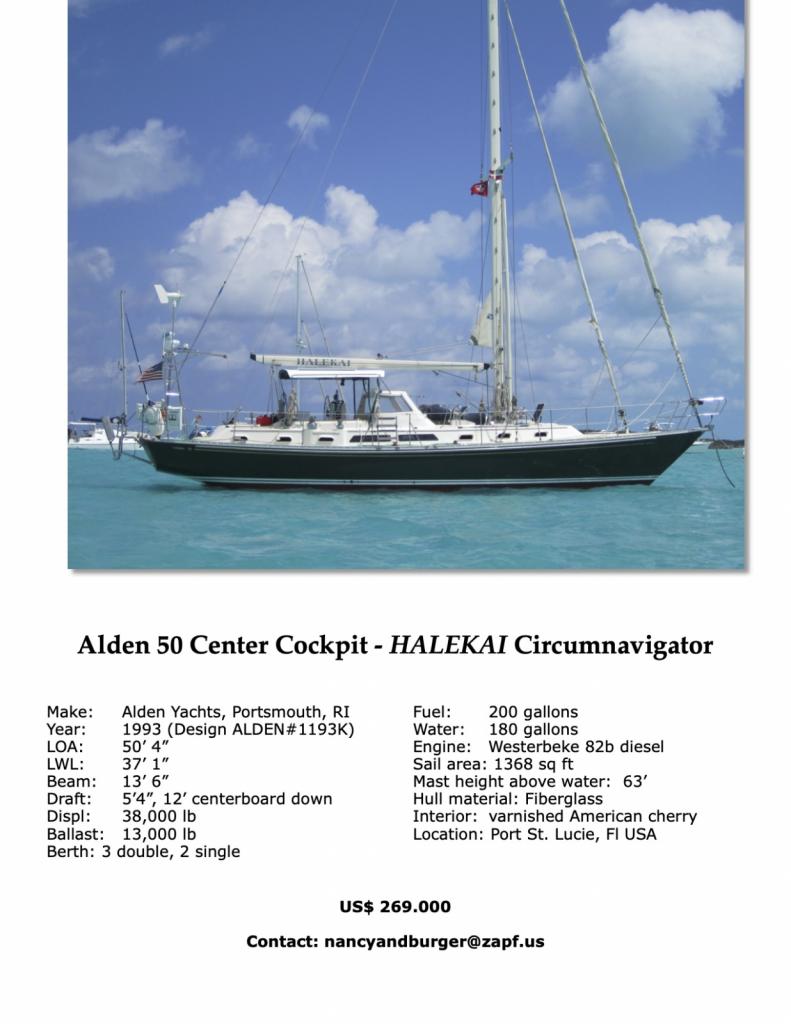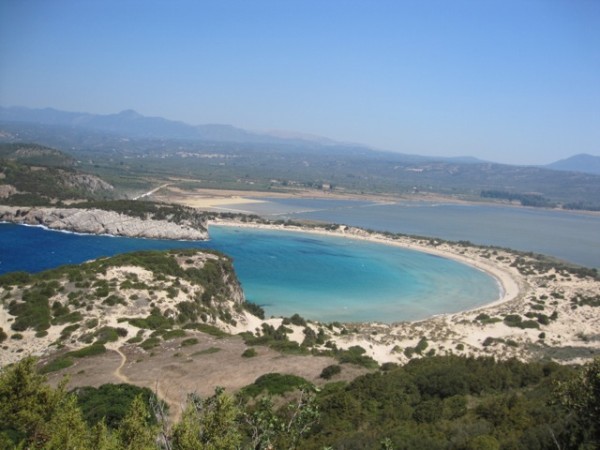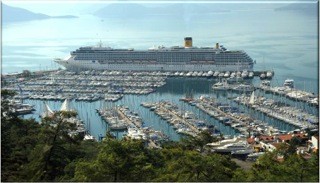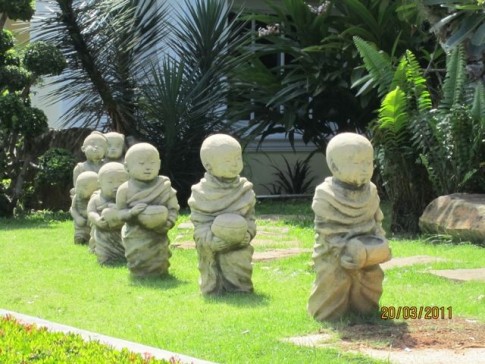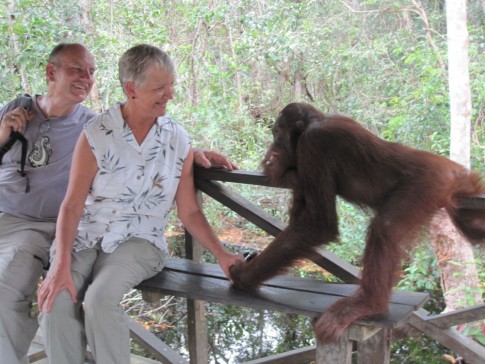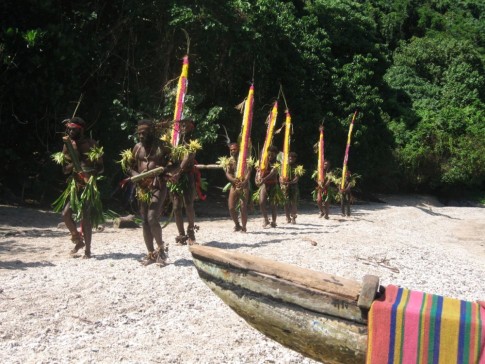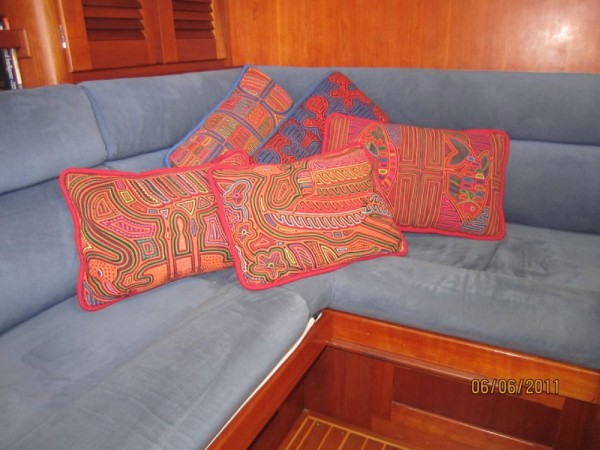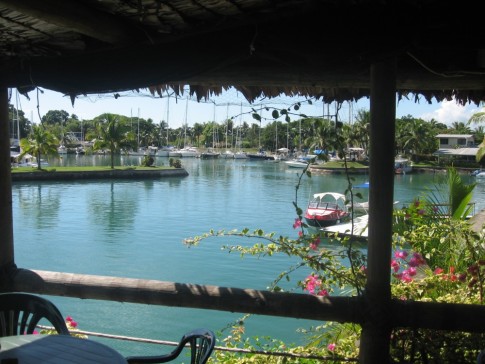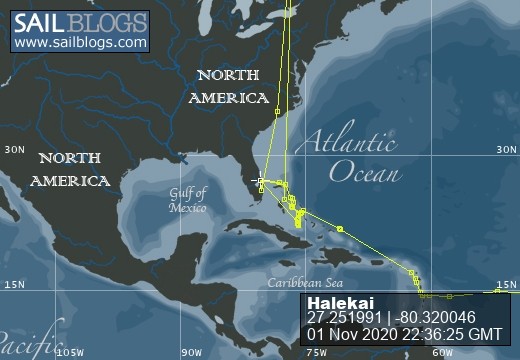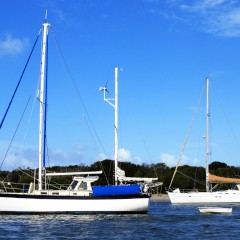
HALEKAI Sailing Around the World
Nancy and Burger invite you to read about their adventures afloat and ashore.
06 April 2017 | St Lucie Inlet, Florida
02 April 2017 | Stocking Island, Exuma
01 April 2017 | George Town, Exumas
30 March 2017 | George Town, Bahamas
22 March 2017 | Elizabeth Island, Exumas
09 March 2017 | George Town, Exumas
04 March 2017 | Thompson's Bay, Long Island
03 March 2017 | Stella Maris, Long Island
02 March 2017 | Long Island
26 February 2017 | Crossing from Water Cay to Comer Channel, Jumentos
25 February 2017 | Double-Breasted Cay to Thompson's Bay, Long Island
23 February 2017 | Double-Breasted Cay, Jumentos
19 February 2017 | Hog Cay, Jumentos
16 February 2017 | Duncan Town, Ragged Island
15 February 2017
14 February 2017 | Hog Cay, Jumentos
10 February 2017 | Hog Cay, the Jumentos
06 February 2017 | Duncan Town, Ragged Island
05 February 2017 | Hog Cay, Ragged Islands
05 February 2017 | Duncan Town, Ragged Island
Farewell to Morocco
15 October 2013 | Bouregreg River, Rabat
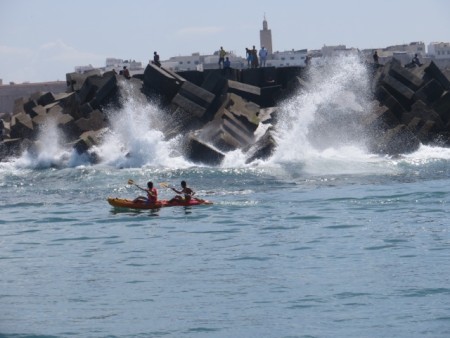
Photo: breakwater at Bouregreg River entrance
It's always hard to leave the comfort of a marina berth, with power and water hook-ups and and easy access to shore. The Bouregreg Marina in Rabat is just a few years old and is kept in excellent condition, especially since the King of Morocco's boats are kept there. We knew several of the cruisers at the marina and more were arriving every day, so there was plenty of social life. But we'd done all the sightseeing we wanted to do, and the Canary Islands were calling.
Entering and leaving the harbor can be dangerous if there's offshore swell, in fact we know of two boats that suffered major damage doing so. Both of them tried to enter without calling the marina first, as you're supposed to do, since it's hard to judge the swell in advance when going in. Sometimes they close the harbor if conditions are bad.
The day we left the swell was starting to climb due to offshore weather far to the north, but we followed the pilot boat out past the breakwater with no problem. The nearly 500 mile trip south along the Moroccan coast and across to the Canaries was a pleasant, mostly downwind ride till our last night, when the wind died and we had to motor the rest of the way. We could see the heavy ship traffic along the coast on our AIS screen but we seldom saw the ships, since they usually divert course around us miles in advance.
It's always hard to leave the comfort of a marina berth, with power and water hook-ups and and easy access to shore. The Bouregreg Marina in Rabat is just a few years old and is kept in excellent condition, especially since the King of Morocco's boats are kept there. We knew several of the cruisers at the marina and more were arriving every day, so there was plenty of social life. But we'd done all the sightseeing we wanted to do, and the Canary Islands were calling.
Entering and leaving the harbor can be dangerous if there's offshore swell, in fact we know of two boats that suffered major damage doing so. Both of them tried to enter without calling the marina first, as you're supposed to do, since it's hard to judge the swell in advance when going in. Sometimes they close the harbor if conditions are bad.
The day we left the swell was starting to climb due to offshore weather far to the north, but we followed the pilot boat out past the breakwater with no problem. The nearly 500 mile trip south along the Moroccan coast and across to the Canaries was a pleasant, mostly downwind ride till our last night, when the wind died and we had to motor the rest of the way. We could see the heavy ship traffic along the coast on our AIS screen but we seldom saw the ships, since they usually divert course around us miles in advance.
Great Oasis Valley Tour: Homeward Stretch
07 October 2013 | High Atlas Mountains to Marrakesh
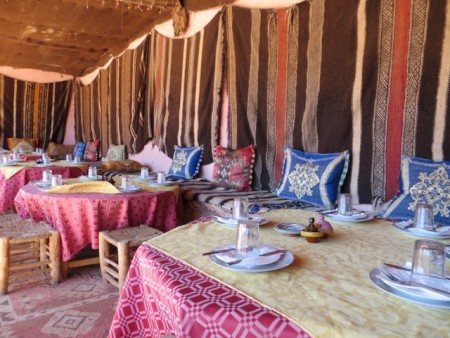
Everywhere we went we were asked where we were from, and received big smiles upon learning we were from America. Barack Obama is very popular in Morocco--as well as everywhere we've traveled to in the past few years, as a matter of fact. "Obama is my cousin," one young man joked. "See, I'm the same color."
Omar returned us to Marrakesh via a different route through the mountains, along a steep, winding road that took us past a dry riverbed that was full of white salt crystals, washed out of the soil by snowmelt each spring (see photos). We had one last lunch on the road--you guessed it, tangine! (actually I ordered a salad instead)--before reaching Marrakesh, where we received a warm welcome from Cherif at our favorite Riad Ker Saada.
We had one last lunch on the road--you guessed it, tangine! (actually I ordered a salad instead)--before reaching Marrakesh, where we received a warm welcome from Cherif at our favorite Riad Ker Saada.
That evening we found Un Dejeuner a Marrakech, a small French terrace restaurant that had wonderful gourmet food! And it wasn't at all expensive. Beef and salmon never tasted so good. The creme brulee duet, one with a hint of mint, the other lemon, were superb. But we had to wait one more day for a glass of wine, upon our return to Halekai in Rabat the next day.
CLICK FOR PHOTOS
Omar returned us to Marrakesh via a different route through the mountains, along a steep, winding road that took us past a dry riverbed that was full of white salt crystals, washed out of the soil by snowmelt each spring (see photos).
 We had one last lunch on the road--you guessed it, tangine! (actually I ordered a salad instead)--before reaching Marrakesh, where we received a warm welcome from Cherif at our favorite Riad Ker Saada.
We had one last lunch on the road--you guessed it, tangine! (actually I ordered a salad instead)--before reaching Marrakesh, where we received a warm welcome from Cherif at our favorite Riad Ker Saada. That evening we found Un Dejeuner a Marrakech, a small French terrace restaurant that had wonderful gourmet food! And it wasn't at all expensive. Beef and salmon never tasted so good. The creme brulee duet, one with a hint of mint, the other lemon, were superb. But we had to wait one more day for a glass of wine, upon our return to Halekai in Rabat the next day.
CLICK FOR PHOTOS
Footbridge Folly of UNESCO
06 October 2013 | Ait Ben Haddou
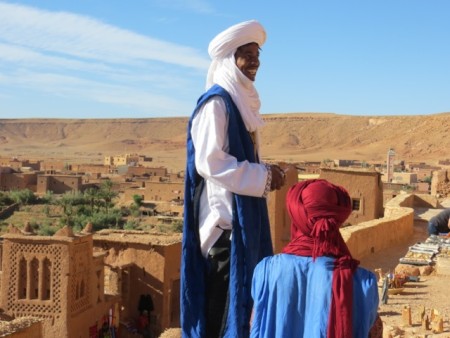
The third and final night of our Great Oasis Desert trip was spent at the very nice Riad Maktoub.  There was a swimming pool, but alas, we had left the hot desert for the cool mountains, and it was too cold to swim in October (too bad we didn't have a pool at the desert riad). But our room was lovely and we enjoyed a romantic dinner (sigh, tangine of course, but at least it was good) at a table next to the softly illuminated pool and surrounding archways.
There was a swimming pool, but alas, we had left the hot desert for the cool mountains, and it was too cold to swim in October (too bad we didn't have a pool at the desert riad). But our room was lovely and we enjoyed a romantic dinner (sigh, tangine of course, but at least it was good) at a table next to the softly illuminated pool and surrounding archways. 
Next morning we were introduced to yet another Mohammed, a handsome young man dressed in a bright blue Muslim robe and red turban. He was to be our guide to the 11th century ksar (fortified village) of Ben Ait Haddou, which was right across the street. Once an important stop-over on the ancient caravan trading route, today it's a UNESCO World Heritage site. Its secondary claim to fame (and fortune) is that it was used as a backdrop in several films such as Gladiator, Alexander and Babel.
The ksar is located across a river which is dry in summer and fall, but raging in spring with snowmelt from the Atlas Mountains. In the past, donkeys led villagers and tourists across the shallow river, but their business dried up, literally, with the building of a modern footbridge funded by UNESCO. The bridge is understandably unpopular with those villagers who lost their donkey transport business, along with those who see its modern design at odds with the medieval town--which is certainly true.
We followed Mohammed across the dry bed and up the steep, uneven steps of a tower of one of the many kasbahs--a multi-story house with four towers and a central courtyard, which once housed all the relatives of a family. We then walked through the narrow streets, past vendors selling handicrafts and artwork. We bought a small watercolor of the ksar for a couple of dollars from Hassan, and some little decorated leather camels from charming young Barack.
We bought a small watercolor of the ksar for a couple of dollars from Hassan, and some little decorated leather camels from charming young Barack.
CLICK FOR PHOTOS
 There was a swimming pool, but alas, we had left the hot desert for the cool mountains, and it was too cold to swim in October (too bad we didn't have a pool at the desert riad). But our room was lovely and we enjoyed a romantic dinner (sigh, tangine of course, but at least it was good) at a table next to the softly illuminated pool and surrounding archways.
There was a swimming pool, but alas, we had left the hot desert for the cool mountains, and it was too cold to swim in October (too bad we didn't have a pool at the desert riad). But our room was lovely and we enjoyed a romantic dinner (sigh, tangine of course, but at least it was good) at a table next to the softly illuminated pool and surrounding archways. 
Next morning we were introduced to yet another Mohammed, a handsome young man dressed in a bright blue Muslim robe and red turban. He was to be our guide to the 11th century ksar (fortified village) of Ben Ait Haddou, which was right across the street. Once an important stop-over on the ancient caravan trading route, today it's a UNESCO World Heritage site. Its secondary claim to fame (and fortune) is that it was used as a backdrop in several films such as Gladiator, Alexander and Babel.

The ksar is located across a river which is dry in summer and fall, but raging in spring with snowmelt from the Atlas Mountains. In the past, donkeys led villagers and tourists across the shallow river, but their business dried up, literally, with the building of a modern footbridge funded by UNESCO. The bridge is understandably unpopular with those villagers who lost their donkey transport business, along with those who see its modern design at odds with the medieval town--which is certainly true.

We followed Mohammed across the dry bed and up the steep, uneven steps of a tower of one of the many kasbahs--a multi-story house with four towers and a central courtyard, which once housed all the relatives of a family. We then walked through the narrow streets, past vendors selling handicrafts and artwork.
 We bought a small watercolor of the ksar for a couple of dollars from Hassan, and some little decorated leather camels from charming young Barack.
We bought a small watercolor of the ksar for a couple of dollars from Hassan, and some little decorated leather camels from charming young Barack.CLICK FOR PHOTOS
Bargaining with Bedouins from Timbuktu
05 October 2013 | Somewhere along the N12 highway
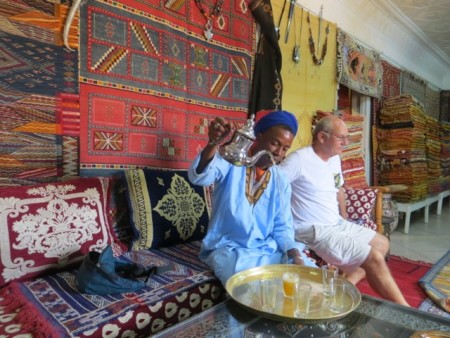
It's easy to be suckered in Morocco! Despite being forewarned of typical high pressure sales techniques, we walked right into a trap, and succumbed.
Omar asked if we wanted to stop at a nomadic Bedouin trading post, and we agreed, not realizing what we were in for. We were ushered into a building and up the stairs to lavish showrooms adorned with carpets and other items and offered mint tea by a tall, imposing man dressed in beautiful robes and turban. Once tea is offered you're stuck, as it's considered impolite to refuse it. He told us that he and his tribe traveled by camel every year, across the Sahara Desert from Timbuktu in Mali through Algeria to Morocco, three months one way in the spring, three months back in the fall. They rode 50 kilometers a day unless there was a sandstorm, in which case they'd only ride 25 km. I asked him if he knew that in English and other western languages, "Timbuktu" means a place very far away, though few actually know where it is. He laughed and said no, he didn't know that.
He told us that he and his tribe traveled by camel every year, across the Sahara Desert from Timbuktu in Mali through Algeria to Morocco, three months one way in the spring, three months back in the fall. They rode 50 kilometers a day unless there was a sandstorm, in which case they'd only ride 25 km. I asked him if he knew that in English and other western languages, "Timbuktu" means a place very far away, though few actually know where it is. He laughed and said no, he didn't know that.  Our host and his young assistant then proceeded to lay out carpets one after the other, although we hadn't expressed interest in buying rugs.
Our host and his young assistant then proceeded to lay out carpets one after the other, although we hadn't expressed interest in buying rugs.  I was fascinated by his technique of measuring the carpets, his arm undulating gracefully and speedily from elbow to bejeweled finger tips across the rug. When we protested that we weren't in the market for a rug, our friend feigned great disappointment. "Please, you must take something back from my people to your people, as a token of our friendship. If not a rug, then surely something else?!"
I was fascinated by his technique of measuring the carpets, his arm undulating gracefully and speedily from elbow to bejeweled finger tips across the rug. When we protested that we weren't in the market for a rug, our friend feigned great disappointment. "Please, you must take something back from my people to your people, as a token of our friendship. If not a rug, then surely something else?!"
He saw Burger looking at a heavy necklace with large polished amber stones and other beads and some silver, and quickly took it out of the display case. The beads were supposedly once used by Bedouins as money, he told us. Then the bargaining began: he wanted "only" 1600 Dirhams ($190) for it. Much too much, protested Burger. He quickly dropped to 1000 DH. Burger countered with 500 ($60), in retrospect surely too much. Flamboyant show of mocked insult. But he'd take 600.

We said no thanks and started to walk out. As we started down the stairs he agreed to our offer, and we were stuck with something we hadn't planned to buy. But now we have a Bedouin memento for our eclectic art collection. The moment money changed hands our host disappeared without so much as a good-bye.
CLICK FOR PHOTOS!
Omar asked if we wanted to stop at a nomadic Bedouin trading post, and we agreed, not realizing what we were in for. We were ushered into a building and up the stairs to lavish showrooms adorned with carpets and other items and offered mint tea by a tall, imposing man dressed in beautiful robes and turban. Once tea is offered you're stuck, as it's considered impolite to refuse it.
 He told us that he and his tribe traveled by camel every year, across the Sahara Desert from Timbuktu in Mali through Algeria to Morocco, three months one way in the spring, three months back in the fall. They rode 50 kilometers a day unless there was a sandstorm, in which case they'd only ride 25 km. I asked him if he knew that in English and other western languages, "Timbuktu" means a place very far away, though few actually know where it is. He laughed and said no, he didn't know that.
He told us that he and his tribe traveled by camel every year, across the Sahara Desert from Timbuktu in Mali through Algeria to Morocco, three months one way in the spring, three months back in the fall. They rode 50 kilometers a day unless there was a sandstorm, in which case they'd only ride 25 km. I asked him if he knew that in English and other western languages, "Timbuktu" means a place very far away, though few actually know where it is. He laughed and said no, he didn't know that.  Our host and his young assistant then proceeded to lay out carpets one after the other, although we hadn't expressed interest in buying rugs.
Our host and his young assistant then proceeded to lay out carpets one after the other, although we hadn't expressed interest in buying rugs.  I was fascinated by his technique of measuring the carpets, his arm undulating gracefully and speedily from elbow to bejeweled finger tips across the rug. When we protested that we weren't in the market for a rug, our friend feigned great disappointment. "Please, you must take something back from my people to your people, as a token of our friendship. If not a rug, then surely something else?!"
I was fascinated by his technique of measuring the carpets, his arm undulating gracefully and speedily from elbow to bejeweled finger tips across the rug. When we protested that we weren't in the market for a rug, our friend feigned great disappointment. "Please, you must take something back from my people to your people, as a token of our friendship. If not a rug, then surely something else?!"He saw Burger looking at a heavy necklace with large polished amber stones and other beads and some silver, and quickly took it out of the display case. The beads were supposedly once used by Bedouins as money, he told us. Then the bargaining began: he wanted "only" 1600 Dirhams ($190) for it. Much too much, protested Burger. He quickly dropped to 1000 DH. Burger countered with 500 ($60), in retrospect surely too much. Flamboyant show of mocked insult. But he'd take 600.

We said no thanks and started to walk out. As we started down the stairs he agreed to our offer, and we were stuck with something we hadn't planned to buy. But now we have a Bedouin memento for our eclectic art collection. The moment money changed hands our host disappeared without so much as a good-bye.
CLICK FOR PHOTOS!
Saharan Sunrise
04 October 2013 | Erg Chebbi Sand Dunes
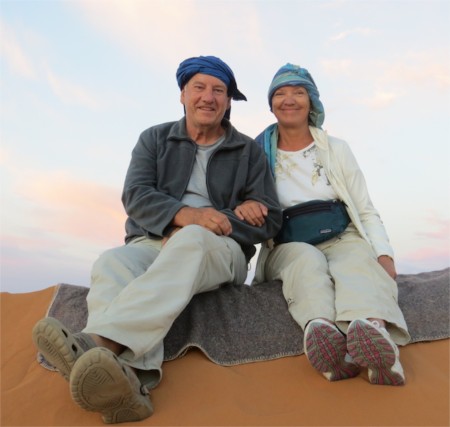
We awoke at 6:30 am and quickly got up, mounted our animals and began the trek back at first light. After a short ride, just before sunrise, our driver signaled our two camels to sit so we could get off, and the three of us then quickly climbed a dune--this time on the side with firmly packed sand, which was easy going. Aha! We learned our dune-climbing lesson the hard way.
We sat in complete silence on the crest of the dune, nothing but sand and sky for miles around, and watched the colors and shadows change as the sun came up (see photos!). What a special treat our guide had given us.
Then it was hike back down for the return trip to the riad. When we dismounted for the final time, Burger's camel once again stretched his neck along the ground and closed his eyes--and then toppled over on his side (see photo)! Was he dead?! After a few seconds he wriggled and sat upright again. Apparently he just had an itch on his side.
We were ravenous by the time we reached the riad, where a sumptuous breakfast awaited us: fresh bread and jam and cheese and an omelet and yogurt, coffee and juice. Wonderful! We then left a lot of sand in the guest room's shower stall. Thus refreshed it was time to meet Omar and resume our journey by car.
CLICK FOR PHOTOS!
We sat in complete silence on the crest of the dune, nothing but sand and sky for miles around, and watched the colors and shadows change as the sun came up (see photos!). What a special treat our guide had given us.
Then it was hike back down for the return trip to the riad. When we dismounted for the final time, Burger's camel once again stretched his neck along the ground and closed his eyes--and then toppled over on his side (see photo)! Was he dead?! After a few seconds he wriggled and sat upright again. Apparently he just had an itch on his side.
We were ravenous by the time we reached the riad, where a sumptuous breakfast awaited us: fresh bread and jam and cheese and an omelet and yogurt, coffee and juice. Wonderful! We then left a lot of sand in the guest room's shower stall. Thus refreshed it was time to meet Omar and resume our journey by car.
CLICK FOR PHOTOS!
It Was a Starry Starry Night
04 October 2013 | Erg Chebbi Sand Dunes
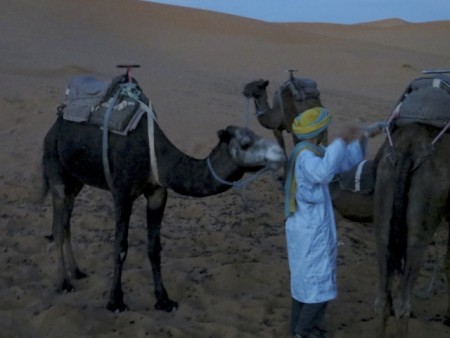
"Hurry, hurry, run up the dune to see the sunset!" urged the camel guides. Have you ever tried to run up a hill of soft sand, with legs like jelly after two hours in the saddle? The sun had set by the time we struggled to the top. Oh well. We see lots of beautiful sunsets from our cockpit, and there's no green flash in the desert. The view was still worth the climb. In the deepening dusk we could still see a range of high, barren mountains to the south that form the northern border of Algeria.
We slalomed back down the dune to camp, flopped onto mattresses and then watched as the stars gradually came out. One of the guides asked us where we were from. "America," we told him. "Ah, America!" he exclaimed. "OH MY COD! IT'S A-MY-ZING!" he mocked. How many times had he heard that before? We could understand why. In total darkness miles from anywhere, the night sky is spectacular. Among the myriad stars we spotted two satellites and a shooting star, and identified the constellations. By the time our dinner was ready (yup, tangine chicken again) the Milky Way was in full splendor.
At around 9:30 pm we were ready for bed, but it was still too warm to sleep in the tent so we slept on the mattresses under the stars, with a lovely light breeze. Camel tours can only be done in spring and fall, we were told, since summer daytime temps can hit 130 F, and winter nights are freezing.
At 3 am we awoke to see Orion's Belt shining brightly above us. After a port-a-potty visit (luckily we had brought headlights) it had cooled down so we retreated inside the bivouac. I had read about snakes and scorpions in the desert, but all we saw was a big, black dung beetle in the sand.
CLICK FOR PHOTOS!
We slalomed back down the dune to camp, flopped onto mattresses and then watched as the stars gradually came out. One of the guides asked us where we were from. "America," we told him. "Ah, America!" he exclaimed. "OH MY COD! IT'S A-MY-ZING!" he mocked. How many times had he heard that before? We could understand why. In total darkness miles from anywhere, the night sky is spectacular. Among the myriad stars we spotted two satellites and a shooting star, and identified the constellations. By the time our dinner was ready (yup, tangine chicken again) the Milky Way was in full splendor.
At around 9:30 pm we were ready for bed, but it was still too warm to sleep in the tent so we slept on the mattresses under the stars, with a lovely light breeze. Camel tours can only be done in spring and fall, we were told, since summer daytime temps can hit 130 F, and winter nights are freezing.
At 3 am we awoke to see Orion's Belt shining brightly above us. After a port-a-potty visit (luckily we had brought headlights) it had cooled down so we retreated inside the bivouac. I had read about snakes and scorpions in the desert, but all we saw was a big, black dung beetle in the sand.
CLICK FOR PHOTOS!
The Great Saharan Desert Adventure
04 October 2013 | Merzouga, Morocco
sunny and hot, upper 90's
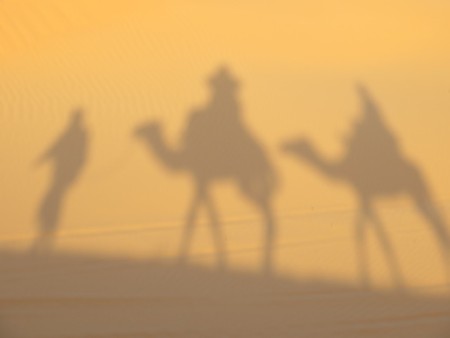
We arrived at the riad in Merzouga late afternoon, deposited our stuff in a guest room and made our way to the waiting camels. Our camel guide Mohammed, dressed in his colorful garb, motioned for us to mount our beasts. No orientation, no instructions, just swing your leg across and hop aboard. Oh, and hang on to the handle bars. Camels stand up in jerky stages, so you lurch way back and way forth till he's up. Then off you go.
The wooden saddles are wrapped in blankets, but it's still a hard seat and a wide straddle, with no stirrups for your dangling legs. Burger decided to ride Lawrence of Arabia-style, and wrapped his legs around the handle bar. Our guide encouraged me to try the same but my legs weren't long enough.
We rode across the golden sand for two hours behind another group of four. I had read that long pants and jogging shoes would be a good idea, as well as a shesh (long scarf) for a turban against sun and blowing sand, but the young Spanish riders ahead of us were barefoot, wore shorts and no headgear.
We arrived at camp, a circle of rectangular tents (bivouacs) at the foot of a high dune, shortly before sunset. The camels lurched down and we dismounted. All the camels except Burger's then sat contentedly with their heads up. Only Burger's stretched his neck down along the sand and closed his eyes, seemingly exhausted. We all had a good laugh. Did the "Lawrence style" give him a neck ache?
CLICK FOR PHOTOS!
The wooden saddles are wrapped in blankets, but it's still a hard seat and a wide straddle, with no stirrups for your dangling legs. Burger decided to ride Lawrence of Arabia-style, and wrapped his legs around the handle bar. Our guide encouraged me to try the same but my legs weren't long enough.
We rode across the golden sand for two hours behind another group of four. I had read that long pants and jogging shoes would be a good idea, as well as a shesh (long scarf) for a turban against sun and blowing sand, but the young Spanish riders ahead of us were barefoot, wore shorts and no headgear.
We arrived at camp, a circle of rectangular tents (bivouacs) at the foot of a high dune, shortly before sunset. The camels lurched down and we dismounted. All the camels except Burger's then sat contentedly with their heads up. Only Burger's stretched his neck down along the sand and closed his eyes, seemingly exhausted. We all had a good laugh. Did the "Lawrence style" give him a neck ache?
CLICK FOR PHOTOS!
The Great Oasis Valley Tour, Day 2
03 October 2013 | Todra Gorge, Erfoud

Driving back down Dades Gorge we got caught in a traffic jam: camels, donkeys, sheep and goats were being herded along the road, and made for some neat photos! Some of them were on their way to a weekly Berber market that we stopped at further along the way (we got there first!). We were the only tourists there. See photos!
We drove along the river valley with date palm groves and stopped at the Todra Gorge, where mountain climbers struggled up sheer rock walls.
After lunch we stopped at the Tahiri museum & store near Erfoud, where we saw a huge collection of fossils, some of which were being prepared for shipment to the annual Tucson, Arizona Mineral, Gem & Fossil Show. We watched skilled craftsmen preparing the fossils, creating beautiful specimens by separating them from the rock. See photos!
CLICK FOR PHOTOS
We drove along the river valley with date palm groves and stopped at the Todra Gorge, where mountain climbers struggled up sheer rock walls.
After lunch we stopped at the Tahiri museum & store near Erfoud, where we saw a huge collection of fossils, some of which were being prepared for shipment to the annual Tucson, Arizona Mineral, Gem & Fossil Show. We watched skilled craftsmen preparing the fossils, creating beautiful specimens by separating them from the rock. See photos!
CLICK FOR PHOTOS
The Great Oasis Valley Tour, Day 1
02 October 2013 | High Atlas Mountains, Ouarzazate, Dades Gorge
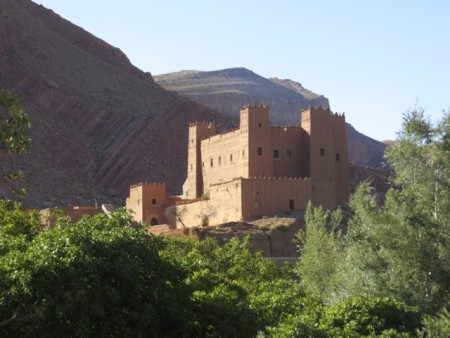
Photo: A kasbah towers over a green river valley, with High Atlas mountains in the background.
We wanted to spend a few days exploring the interior of Morocco and do the tourist thing--take a camel ride and spend a night in the desert--but we decided against renting a car since it would mean strenuous driving on windy mountain roads. Lots of organized tours originate in Marrakesh, and our riad host Cherif had a tour desk. Since it was last-minute we weren't able to join a group, we decided to splurge on a private tour. We didn't regret it. Omar spoke reasonable English, was professional and a good driver.
We set off early next morning in a comfortable SUV and headed south. The road gradually climbed up the rugged High Atlas Mountains to the pass, at 7400 feet. The highest of the High is twice that altitude. Berber villages blended perfectly into the landscape, the flat-roofed houses made of clay mixed with the straw. Each village had an attractive mosque with a square tower, usually in better condition than any other building.
We stopped for lunch in Ouarzazate (Wahr-za-zat), a large town best known for the Atlas Studio, where movies such as Lawrence of Arabia (which we had just watched, along with Black Gold, to prepare us for the trip), Kingdom of Heaven and the Mummies were filmed. The Studio is still in use but no movies were being made when we toured the sets.
Then we continued onward to the Dades Valley, with its refreshingly green river beds, and up the switchback road to the Dades Gorge (see photos), where we stayed in a nice riad overnight.
Dinner was soup, tangine chicken with veggies and potatoes, and melon for dessert. We were soon to tire of tangine, one of the few items on most Morrocan menus. Others are couscous with veggies and meat, or brochette, which is skewers of meat or chicken with veggies and French fries. Omelette and salad were about the only other choices. Most everything lacked enough salt or seasonings. Since Muslims don't drink alcohol few restaurants have liquor licenses, we had a "dry" week with no wine or beer. Despite eating out 3x day for a week, I actually lost weight!
CLICK FOR PHOTOS
We wanted to spend a few days exploring the interior of Morocco and do the tourist thing--take a camel ride and spend a night in the desert--but we decided against renting a car since it would mean strenuous driving on windy mountain roads. Lots of organized tours originate in Marrakesh, and our riad host Cherif had a tour desk. Since it was last-minute we weren't able to join a group, we decided to splurge on a private tour. We didn't regret it. Omar spoke reasonable English, was professional and a good driver.
We set off early next morning in a comfortable SUV and headed south. The road gradually climbed up the rugged High Atlas Mountains to the pass, at 7400 feet. The highest of the High is twice that altitude. Berber villages blended perfectly into the landscape, the flat-roofed houses made of clay mixed with the straw. Each village had an attractive mosque with a square tower, usually in better condition than any other building.
We stopped for lunch in Ouarzazate (Wahr-za-zat), a large town best known for the Atlas Studio, where movies such as Lawrence of Arabia (which we had just watched, along with Black Gold, to prepare us for the trip), Kingdom of Heaven and the Mummies were filmed. The Studio is still in use but no movies were being made when we toured the sets.
Then we continued onward to the Dades Valley, with its refreshingly green river beds, and up the switchback road to the Dades Gorge (see photos), where we stayed in a nice riad overnight.
Dinner was soup, tangine chicken with veggies and potatoes, and melon for dessert. We were soon to tire of tangine, one of the few items on most Morrocan menus. Others are couscous with veggies and meat, or brochette, which is skewers of meat or chicken with veggies and French fries. Omelette and salad were about the only other choices. Most everything lacked enough salt or seasonings. Since Muslims don't drink alcohol few restaurants have liquor licenses, we had a "dry" week with no wine or beer. Despite eating out 3x day for a week, I actually lost weight!
CLICK FOR PHOTOS
All Aboard the Marrakesh Express!
01 October 2013 | Marrakesh, Morocco
warm and sunny, mid 80's
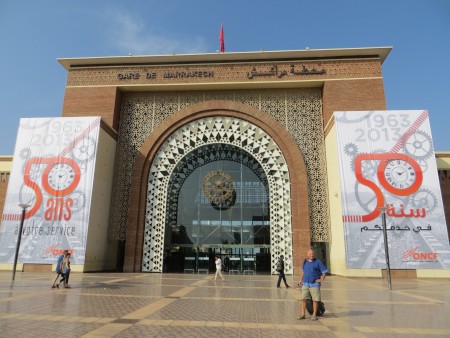
Photo: Burger in front of the Gare du Marrakech (train station)
The song Marrakesh Express came out back in 1969, the year we were married. Forty-three years later, we boarded the train from Rabat to Marrakesh, one of Morocco's most popular tourist destinations. The trains as well as the train stations are among the most modern and clean we've ever seen.
Across from us sat a young man who wanted to practice his English. He spoke it amazingly well, considering he said he just started learning it six months ago! He was an economics student who was planning to take a class trip to Boston next month. We promised to set him in touch with a friend who lives in Boston and who once studied economics there.
He returned the favor by calling a friend on his cell phone who picked us up from the train station in Marrakesh and took us to the outskirts of the medina, where the pedestrian area begins. The winding cobblestone alleyways (derbs), designed centuries ago to thwart invaders, are so confusing that we had to hire a porter to escort us to our riad (guesthouse), and even he had trouble finding it.
Once inside the Riad Ker Saada (www.riadkersaada.com), we were welcomed with freshly pressed orange juice in the courtyard. It was a peaceful retreat from the hectic life outside. A huge banana plant took center stage. We carried our bags up a stone staircase with uneven steps, which are common in medieval buildings. Supposedly stairs were made uneven on purpose in order to discourage enemies. It's hard to run up or down uneven steps! Our room, one of six, overlooked the courtyard. Tasteful modern artwork contrasted with traditional decor.
The owner, Cherif, was a wonderfully kind and helpful host. He escorted us through the maze of narrow streets to the main square (Djemaa el Fna), pointing out landmarks for finding our way back--which wasn't easy! (Turn left at the wrought iron archway, left at the two bakeries, right at the dumpster ...). We had dinner in one of the restaurants that overlook Djemaa el Fna, which comes to life at sunset and swarms with tourists and locals.
Next morning, after breakfast served on the rooftop terrace of our riad (homemade flatbread with butter and jam, juice and coffee), we explored the sights of the city. We toured both the busy medina within the city walls, with its palaces and colorful labyrinth of markets (souk), as well as the outlying surroundings of fancy hotels and golf courses. The highlight of the day was visiting the enchanting Majorelle Garden and Museum, once owned by Yves Saint Laurent. www.jardinmajorelle.com
CLICK FOR PHOTOS
The song Marrakesh Express came out back in 1969, the year we were married. Forty-three years later, we boarded the train from Rabat to Marrakesh, one of Morocco's most popular tourist destinations. The trains as well as the train stations are among the most modern and clean we've ever seen.
Across from us sat a young man who wanted to practice his English. He spoke it amazingly well, considering he said he just started learning it six months ago! He was an economics student who was planning to take a class trip to Boston next month. We promised to set him in touch with a friend who lives in Boston and who once studied economics there.
He returned the favor by calling a friend on his cell phone who picked us up from the train station in Marrakesh and took us to the outskirts of the medina, where the pedestrian area begins. The winding cobblestone alleyways (derbs), designed centuries ago to thwart invaders, are so confusing that we had to hire a porter to escort us to our riad (guesthouse), and even he had trouble finding it.
Once inside the Riad Ker Saada (www.riadkersaada.com), we were welcomed with freshly pressed orange juice in the courtyard. It was a peaceful retreat from the hectic life outside. A huge banana plant took center stage. We carried our bags up a stone staircase with uneven steps, which are common in medieval buildings. Supposedly stairs were made uneven on purpose in order to discourage enemies. It's hard to run up or down uneven steps! Our room, one of six, overlooked the courtyard. Tasteful modern artwork contrasted with traditional decor.
The owner, Cherif, was a wonderfully kind and helpful host. He escorted us through the maze of narrow streets to the main square (Djemaa el Fna), pointing out landmarks for finding our way back--which wasn't easy! (Turn left at the wrought iron archway, left at the two bakeries, right at the dumpster ...). We had dinner in one of the restaurants that overlook Djemaa el Fna, which comes to life at sunset and swarms with tourists and locals.
Next morning, after breakfast served on the rooftop terrace of our riad (homemade flatbread with butter and jam, juice and coffee), we explored the sights of the city. We toured both the busy medina within the city walls, with its palaces and colorful labyrinth of markets (souk), as well as the outlying surroundings of fancy hotels and golf courses. The highlight of the day was visiting the enchanting Majorelle Garden and Museum, once owned by Yves Saint Laurent. www.jardinmajorelle.com
CLICK FOR PHOTOS
Here's Looking at You, Kid!
28 September 2013 | Casablanca
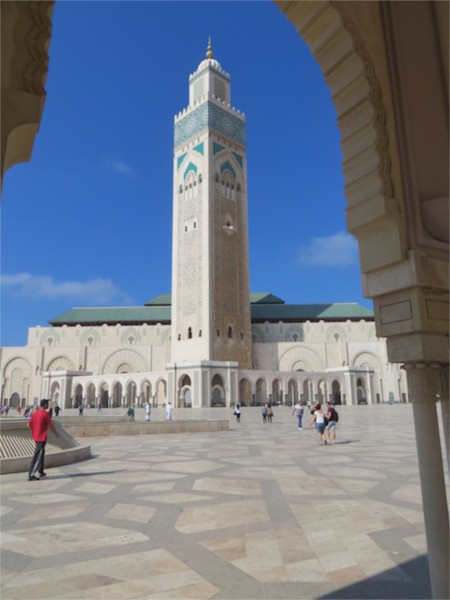
The next day the six of us took the modern, fast train to Casablanca, less than an hour and a half down the coast. We watched the movie Casablanca the night before to get in the mood, but unfortunately didn't find Rick's Bar--which opened long after the movie was filmed, but still ...
The city doesn't have much in the way of sightseeing interest, but we did tour the main attraction, the beautiful Hassan II Mosque, completed just 20 years ago. And we had lunch at a fancy but inexpensive Moroccan restaurant.
CLICK FOR PHOTOS
The city doesn't have much in the way of sightseeing interest, but we did tour the main attraction, the beautiful Hassan II Mosque, completed just 20 years ago. And we had lunch at a fancy but inexpensive Moroccan restaurant.
CLICK FOR PHOTOS
Come with Me to the Kasbah
26 September 2013 | Rabat and Sale, Morocco
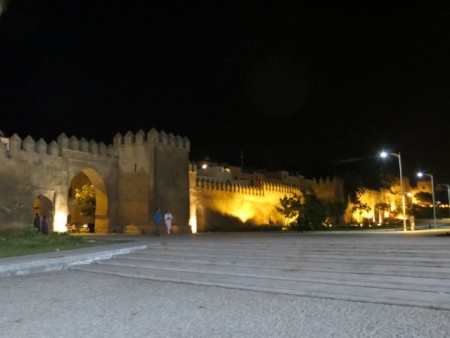
If it weren't for the Muslim dress, the Mosques and the loudspeakers calling to prayer, you would think you were in a Western country, at least in the modern parts of town. From the marina we can see nearly silent trams and traffic on a highway that connect the two cities of Rabat and Sale across the River Bouregreg.
But enter the gate of a kasbah (walled citadel) and you're quickly in another world. Click the link below for photos of us wandering the streets of the medinas (medieval part of town) of Rabat and Sale, together with our friends.
Cats are everywhere, such great photo models they are. But we saw almost no dogs. Muslims believe that dogs are unclean.
CLICK FOR PHOTOS
A few days later we ventured into Rabat again, this time for sightseeing at the 12th century Hassan Tower and the adjacent Mausoleum:
CLICK FOR MORE PHOTOS
But enter the gate of a kasbah (walled citadel) and you're quickly in another world. Click the link below for photos of us wandering the streets of the medinas (medieval part of town) of Rabat and Sale, together with our friends.
Cats are everywhere, such great photo models they are. But we saw almost no dogs. Muslims believe that dogs are unclean.
CLICK FOR PHOTOS
A few days later we ventured into Rabat again, this time for sightseeing at the 12th century Hassan Tower and the adjacent Mausoleum:
CLICK FOR MORE PHOTOS
A Tumultuous Exit from the Med
24 September 2013 | Rabat, Morocco
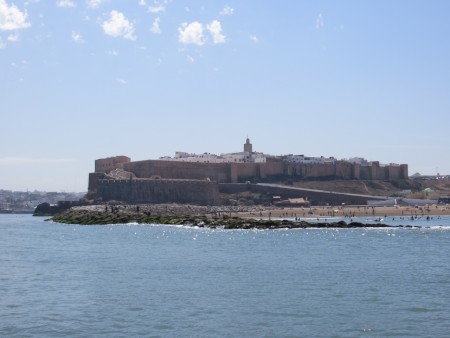
Photo: Entering the Bouregreg River channel, with view of the Rabat's Kashbah and the public beach to the right of the breakwater.
Just a quick note to say we arrived safely in Rabat the day before yesterday, after an overnight trip from La Linea/Bay of Gibraltar. We had 30+ knots gusting to 40 in the Strait and even after reducing sail to just our staysail, we still zoomed along at 7 knots plus 2 knots of current. It was exhilarating! But once around the Cape and down the Moroccan coast a few miles, the wind suddenly shut off. We motored all night at 4 knots so as to arrive in Rabat after low water, since the chart showed a shallow bar at the entrance to the river. But they've been dredging recently and we saw no less than 12 feet two hours after low water.
We were escorted up the river by the marina's pilot boat, and felt like celebrities and ambassadors to America, waving to onlookers ashore. Several people shouted, "Welcome to Morocco." We tied up to the Customs and fuel dock, cleared into the country quickly and took on fuel, much cheaper than in Spain. A sniffer dog gave his approval that no drugs were aboard. Then we were ushered to our berth in the modern marina.
Strangely, the marina's wifi won't let us access gmail, hotmail, yahoo mail or FaceBook so we haven't been able to let anyone know we're here. They've evidently filtered all encrypted websites. We finally got a sailmail message out to our daughters via the SSB radio, and have now discovered we can post here on Sailblogs.
CLICK FOR PHOTOS
Just a quick note to say we arrived safely in Rabat the day before yesterday, after an overnight trip from La Linea/Bay of Gibraltar. We had 30+ knots gusting to 40 in the Strait and even after reducing sail to just our staysail, we still zoomed along at 7 knots plus 2 knots of current. It was exhilarating! But once around the Cape and down the Moroccan coast a few miles, the wind suddenly shut off. We motored all night at 4 knots so as to arrive in Rabat after low water, since the chart showed a shallow bar at the entrance to the river. But they've been dredging recently and we saw no less than 12 feet two hours after low water.
We were escorted up the river by the marina's pilot boat, and felt like celebrities and ambassadors to America, waving to onlookers ashore. Several people shouted, "Welcome to Morocco." We tied up to the Customs and fuel dock, cleared into the country quickly and took on fuel, much cheaper than in Spain. A sniffer dog gave his approval that no drugs were aboard. Then we were ushered to our berth in the modern marina.
Strangely, the marina's wifi won't let us access gmail, hotmail, yahoo mail or FaceBook so we haven't been able to let anyone know we're here. They've evidently filtered all encrypted websites. We finally got a sailmail message out to our daughters via the SSB radio, and have now discovered we can post here on Sailblogs.
CLICK FOR PHOTOS
In Search of the Blue Medina
03 September 2013 | Chefchaouen, Morocco
warm and sunny
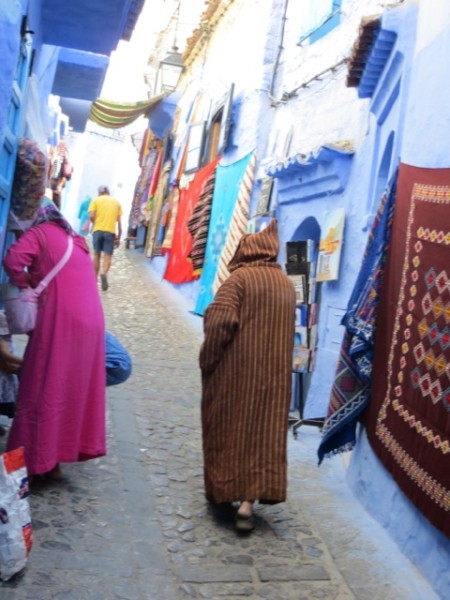
While in Spanish Ceuta we decided to venture into Morocco for a day, so we rented a car and set off early next morning. Having read that it's best to get Moroccan money from an ATM once in the country, our adventure began when Burger stuck our debit card into the machine at the border, and it was "eaten"! The machine was attached to a bank, but it wasn't due to open for two hours. Disconcerted, we carried on and changed some Euros for Dirhams at Chefchaouen, our destination.
At first we drove south along a fast highway that bypassed the small city of Tetouan, with its tightly clustered, white flat-roofed houses. Then we climbed into the refreshingly green Rif mountains along a windy, two-lane road, well paved with only the occasional pothole. Thank goodness for our Ipad nav program, as the signs weren't always helpful. Burger proved just as capable of passing slow trucks as the locals--not sure that's a good thing? (see photo).
Chaouen ("chow-en"), as it's nicknamed, is famous for its blue-colored medieval old town (medina) built into a hillside, above the modern part of town. At first we couldn't find the medina and wondered why we'd just driven all that way to a rather ugly, bustling little place, unpleasant on a hot day. How do the Muslims survive the heat in their long clothing and head covering? Finally we asked directions in our stumbling French--amazing how words come back to you that you haven't spoken in years ("ou est le medina, s'il vous plait?) and at last we found the entrance arch.
Built by the Portuguese as a base camp to launch attacks against Ceuta in the 15th century, the town changed hands a few times over the centuries (typical of everywhere in Europe). When Jews expelled from Spain settled in Chaouen a couple of centuries later, they chose to paint their houses and the narrow, cobblestone lanes various shades of blue. To this day the medina is mostly blue, which has made it such a tourist attraction.
The streets were filled with vendors selling souvenirs, tin and brass items, brightly colored spools of thread, clothing, straw hats, etc. One hat style looked like a clown's hat with colored balls on it, which we saw both men and women wearing.
Muslim-dressed women carried large, flat loaves of bread to and from the communal bakeries, and filled plastic jugs from water fountains. Lots of children were playing, and there were skinny cats everywhere. The occasional Rifi Berber walked by, wearing a long, brown, hooded robe looking just like a Jedi in StarWars (see photo).
A donkey passed us (see his photo too), carrying propane tanks on his back. He looked so very sad. We walked to the end of town and looked down at a waterfall and river, where locals were washing their clothes. Colorful cloths were drying on nearby rooftops.
We had lamb tangine, a sort of stew, for lunch at an outdoor cafe shaded by grapevines. The waiter was ever so nice and friendly, but the food was mediocre. Tangine is supposed to be sweet and spicy, but ours was bland, completely lacking in spices. We'll have to try it again somewhere less touristy.
We then made our way back down to our car and drove back to Ceuta. What luck! The bank at the border crossing was open when we got there--an adventure in itself driving through the throngs to get to it--and, amazingly, they retrieved our card from the ATM machine unharmed and returned it to us!
PHOTOS CLICK HERE
At first we drove south along a fast highway that bypassed the small city of Tetouan, with its tightly clustered, white flat-roofed houses. Then we climbed into the refreshingly green Rif mountains along a windy, two-lane road, well paved with only the occasional pothole. Thank goodness for our Ipad nav program, as the signs weren't always helpful. Burger proved just as capable of passing slow trucks as the locals--not sure that's a good thing? (see photo).
Chaouen ("chow-en"), as it's nicknamed, is famous for its blue-colored medieval old town (medina) built into a hillside, above the modern part of town. At first we couldn't find the medina and wondered why we'd just driven all that way to a rather ugly, bustling little place, unpleasant on a hot day. How do the Muslims survive the heat in their long clothing and head covering? Finally we asked directions in our stumbling French--amazing how words come back to you that you haven't spoken in years ("ou est le medina, s'il vous plait?) and at last we found the entrance arch.
Built by the Portuguese as a base camp to launch attacks against Ceuta in the 15th century, the town changed hands a few times over the centuries (typical of everywhere in Europe). When Jews expelled from Spain settled in Chaouen a couple of centuries later, they chose to paint their houses and the narrow, cobblestone lanes various shades of blue. To this day the medina is mostly blue, which has made it such a tourist attraction.
The streets were filled with vendors selling souvenirs, tin and brass items, brightly colored spools of thread, clothing, straw hats, etc. One hat style looked like a clown's hat with colored balls on it, which we saw both men and women wearing.
Muslim-dressed women carried large, flat loaves of bread to and from the communal bakeries, and filled plastic jugs from water fountains. Lots of children were playing, and there were skinny cats everywhere. The occasional Rifi Berber walked by, wearing a long, brown, hooded robe looking just like a Jedi in StarWars (see photo).
A donkey passed us (see his photo too), carrying propane tanks on his back. He looked so very sad. We walked to the end of town and looked down at a waterfall and river, where locals were washing their clothes. Colorful cloths were drying on nearby rooftops.
We had lamb tangine, a sort of stew, for lunch at an outdoor cafe shaded by grapevines. The waiter was ever so nice and friendly, but the food was mediocre. Tangine is supposed to be sweet and spicy, but ours was bland, completely lacking in spices. We'll have to try it again somewhere less touristy.
We then made our way back down to our car and drove back to Ceuta. What luck! The bank at the border crossing was open when we got there--an adventure in itself driving through the throngs to get to it--and, amazingly, they retrieved our card from the ATM machine unharmed and returned it to us!
PHOTOS CLICK HERE
| Vessel Name: | Halekai |
| Vessel Make/Model: | Alden 50 Center Cockpit |
| Hailing Port: | Berlin |
| Crew: | Nancy and Burger Zapf |
| About: | |
| Extra: | |
| Home Page: | http://www.sailblogs.com/member/halekai |
| Social: |
Halekai's Photos - Main
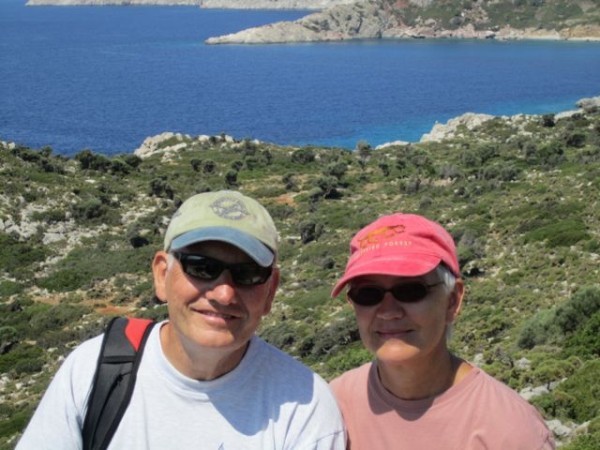 |
After visiting the famous pilgramage for sailors, the Monastery of the Archangel Michael in Panormitis, we sailed around to the main town of Symi.
18 Photos
Created 6 June 2012
|
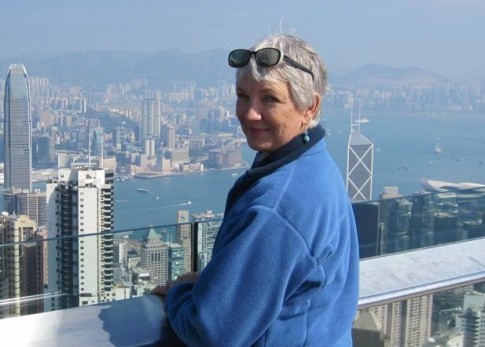 |
Our three-day stopover in Hong Kong to celebrate our 41st anniversary
67 Photos
Created 25 December 2010
|
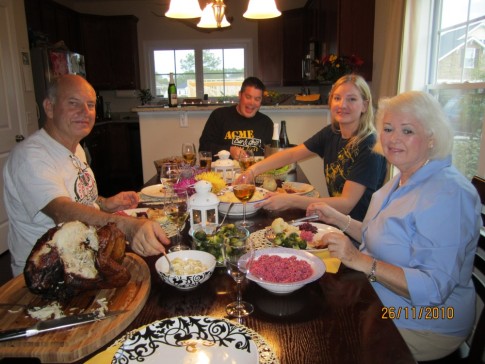 |
Thanksgiving in Wilmington, NC with our daughters and their families
33 Photos | 1 Sub-Album
Created 7 December 2010
|
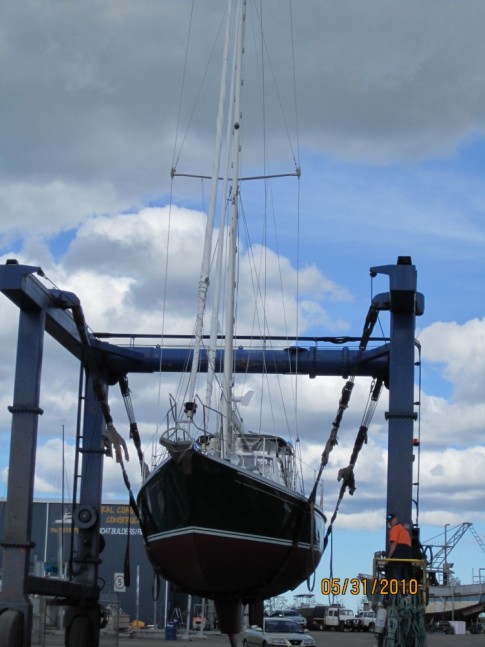 |
We left Bundaberg late June and sailed up the coast of Queensland, inside the Great Barrier Reef.
10 Photos | 5 Sub-Albums
Created 13 August 2010
|
s/v HALEKAI
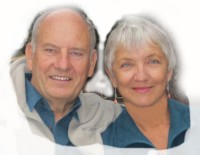
Who: Nancy and Burger Zapf
Port: Berlin
Follow Our Tracks
Links to all Logs
Logs and Links
- Halekai for sale
- 2017 Bahamas
- 2014 IntraCoastal Waterway
- 2014 Bahamas
- 2014 Leeward Islands
- 2013 Mindelo, Cape Verde
- 2014 Atlantic Crossing
- 2013 Canary Islands
- 2013 Morocco
- 2013 Gibraltar
- 2013 Spain
- 2013 Balearics
- 2012-13 Italy
- 2012 Greece
- 2011-12 Turkey
- 2010 Malacca Strait
- 2011 Thailand
- Trips Home
- 2011 Malaysia
- Medical Volunteer Trips to Ecuador
- 2010 Hong Kong
- 2010 Indonesia
- 2010 Australia
- 2009 Vanuatu
- Show All Posts
- Modifying HALEKAI for World Cruising
- CW: Things I Wish I'd Known
- BWS: Social Networking at Sea
- Cruiser Notes: Bundy to Darwin, AU
- Cruiser Notes: Canary Islands
- Cruiser Notes: Cape Verde Islands
- Cruiser Notes: Exploring Southern Turkey
- Cruiser Notes: Indonesian Rumors Debunked
- Cruiser Notes: Wintering in Marmaris, Turkey
- Cruising Compass e-zine
- Ocean Cruising Club
- Ocean Navigator e-zine
- Noonsite global site for cruisers
- PassageWeather for sailors
- Practical Sailor e-zine
- SBI Cruisers' Mail Forwarding Service
- Seven Seas Cruising Association
- Tarpon Bay Yacht Club
- Trans-Ocean Club Germany
- WindFinder wind, wave & weather
- World Cruising & Sailing Wiki

